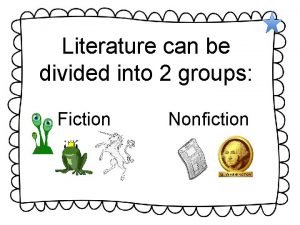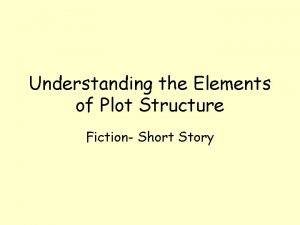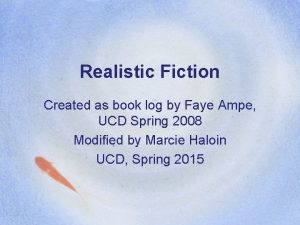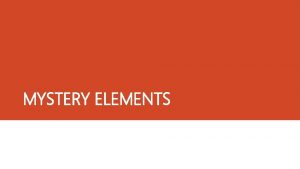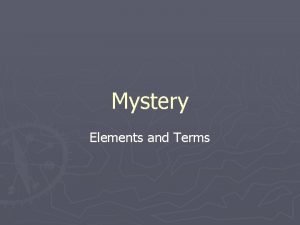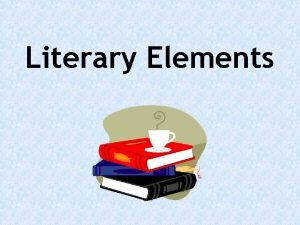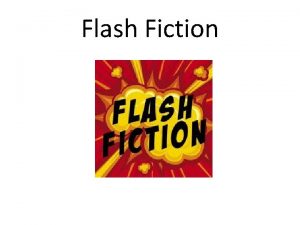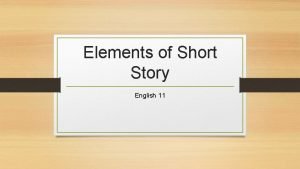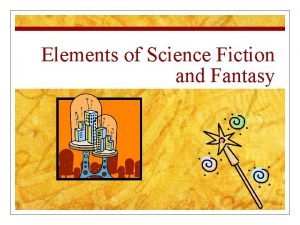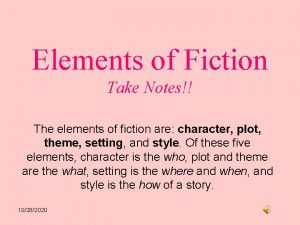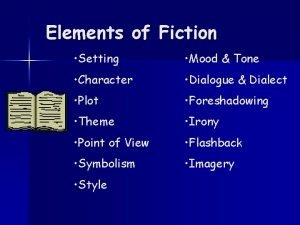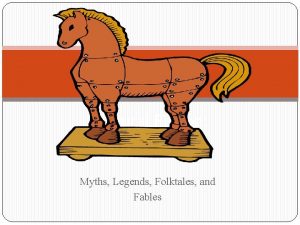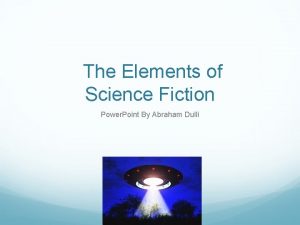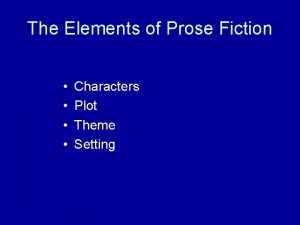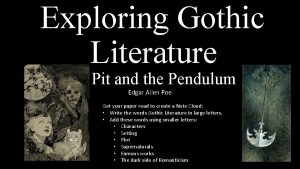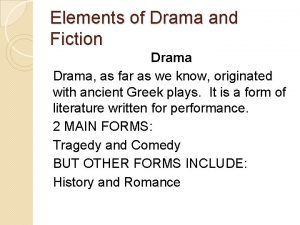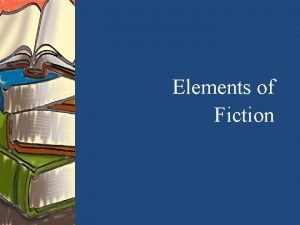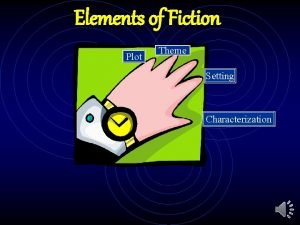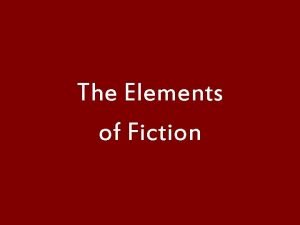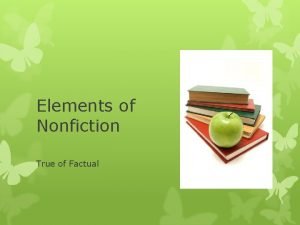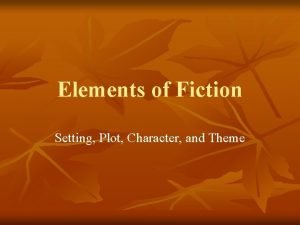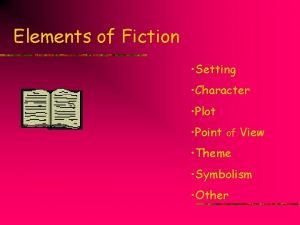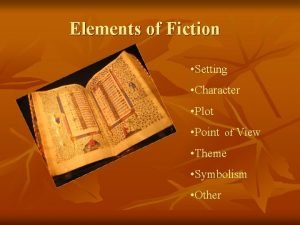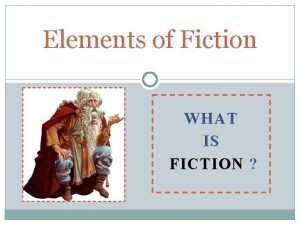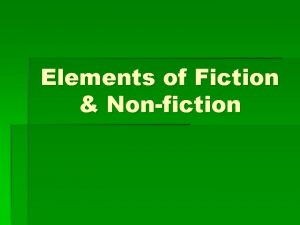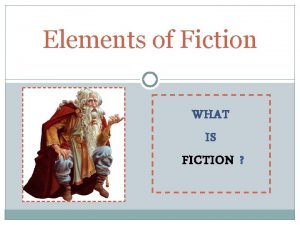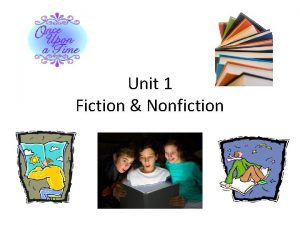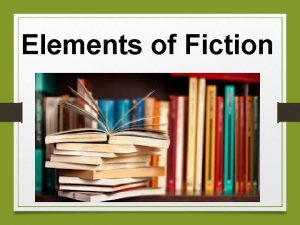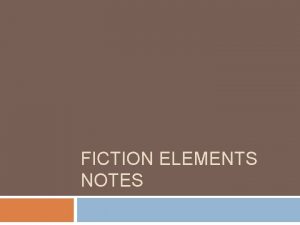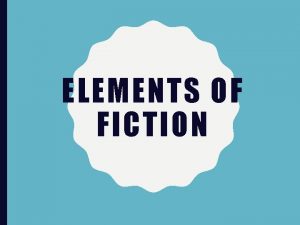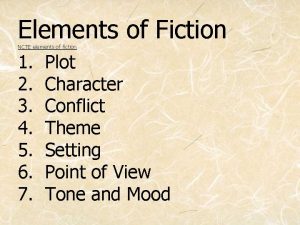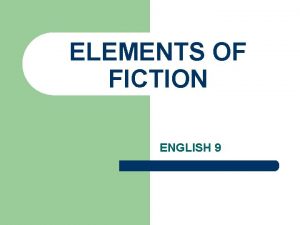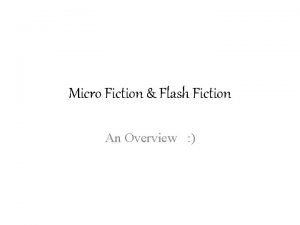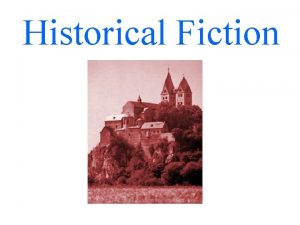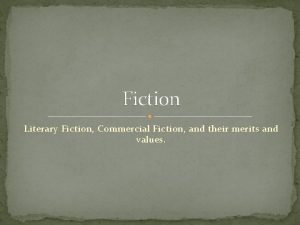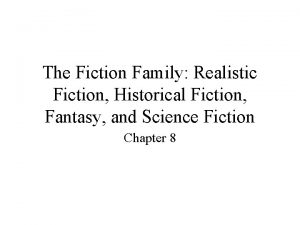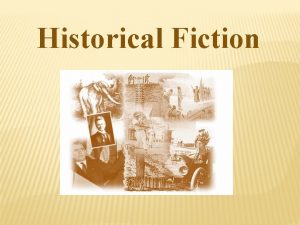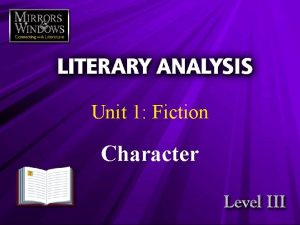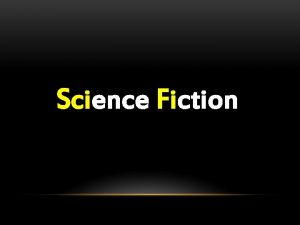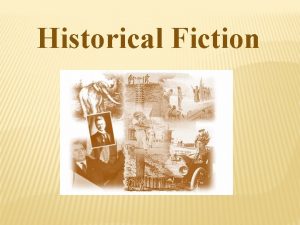Elements of Fiction English What is Fiction Fiction
































- Slides: 32

Elements of Fiction English

What is Fiction? Fiction: a narrative prose about characters and events from the author’s imagination While it can be based on real events, fiction is not the truth Fiction can come in many forms or types.

Types of Written Fiction Short Story: Brief narratives that allow the author to focus on one particular main plot complication Novella: Intermediate works of fiction that are longer than short stories but more concise and shorter than novels Novel: Extended works of fiction that are often organized into segments called chapters Novels may include subplots in addition to the “main” storyline and may explore multiple characters in depth.

Genre is a type of literature. The main genres are prose, poetry and drama. Each of these is then divided into smaller genres (prose: fiction and nonfiction). It also refers to subcategories of literature, such as fantasy, science fiction, historical fiction. Genre list: How many genres can we come up with?

Elements of Fiction: Setting: the place where the story takes place Setting can include: The geographical location (ex. Wyoming, London, Vancouver) The time period (ex. 1865, during WWII, today) The socio-economic characteristics of the location (ex. wealthy suburbs, the low-income housing district) The specific building, room and so forth (ex. a log cabin, a prep school, a bus)

Elements of Fiction: Setting (Cont. ) Setting can tell us about the characters. The way a character interacts with the setting might mean different things. Perhaps a character is bumping into things or breaking things, making them careless. Perhaps the setting is in a place the character isn’t familiar with, so they’re always lost. Setting can be used to set the tone or the atmosphere for the story. Example: “During the whole of a dull, dark and soundless day in the autumn of the year, when the clouds hung oppressively low in the heavens, I had been passing alone, on horseback, through a singularly dreary tract of country. ” - “The Fall of the House of Usher, ” Edgar Allan Poe

Elements of Fiction: Characters Protagonist Characters: the people (or animals/things presented as people) appearing in a literary work Protagonist: The main character in a literary work. There can be more than one (though it might be rare). Examples in Literature: Harry Potter in the Harry Potter series, Katniss Everdeen in The Hunger Games Examples in Television? Discuss

Characters: Antagonist - Foil Antagonist: The character who opposes the protagonist (sometimes there are more than one antagonist). Examples in Literature: Voldemort in the Harry Potter series, President Snow in The Hunger Games Examples in Television? Discuss Character foil – A character who provides a strong contrast to another character, usually a main character. By using this, a writer calls attention to the strengths and weaknesses of a character. (Dr. Jekyll and Mr. Hyde)

Elements of Fiction: Characters There are many types of characters: Round Characters: convincing and true to life characters who have many different and sometimes even contradictory personality traits Dynamic Characters: characters who undergo some type of change or development in the story, often because of something that happens to them Flat Characters: stereotypes, shallow or symbolic characters who have only one or two personality traits Static characters: characters who do not change in the course of the story

Methods of Characterization means the methods that a writer uses to develop a character. There are two main methods of characterization: Direct Characterization: The author develops the personality of a character through direct statements. Example: “Dottie was the talker, the outgoing one – the extrovert. ” Indirect Characterization: Revealing a character’s personality through: The characters thoughts, words and actions The comments of OTHER characters The character’s physical appearance

Indirect Characterization: Through Thoughts “He couldn’t believe what he had gotten himself into. How had this happened? He’d never so much as held a gun in his life, much less gone hunting for animals. ”

Indirect Characterization: Through Words “‘It’s a mystery, ’ replied the Lion. ‘I suppose I was born that way. All the other animals in the forest naturally expect me to be brave, for the Lion is everywhere thought to be the King of Beasts. I learned that if I roared very loudly every living thing was frightened and got out of my way. Whenever I’ve met a man I’ve been awfully scared; but I just roared at him, and he has always run away as fast as he could go. If the elephants and the tigers and the bears had ever tried to fight me, I should have run myself. ’”

Indirect Characterization: Through Actions “The boy held his breath; he wondered whether his father would hear his heart beating… Through a crack in the counter he could see his father where he stood, one hand held to his high stiff collar…”

Indirect Characterization: Through Appearance “Miss Kinney was young and blonde and bouncy and had a boyfriend who picked her up after school in a blue Camaro. ”

Elements of Fiction: Plot: the literary element that describes the structure of the story. It shows arrangement of events and actions within a story.

Components of Plot Exposition: The start of the story, the situation before the action starts (usually there is some explanation of the background and setting) Rising Action: The series of conflicts and crisis in the story that lead to the climax Climax: The turning point, the most intense moment – either mentally or in action Falling Action: All of the action which follows the climax Resolution: The conclusion, the tying together of all the threads Nowadays there are some stories and movies that leave the resolution to the watcher/reader imagination

Types of Plot Linear – when the story follows the plot diagram and does not skew from that order. It is in chronological order. Circular – follows a “round” pattern – the story begins and ends in the same way, like cycle of seasons or of life. This plot follows a predictable series of events that returns to the starting point. Subplot – a secondary plot. It is not the main conflict, but still develops throughout the story. It often runs parallel to the main plot and supports it. Ex: In The Hunger Games series, the love triangle is a subplot. The main plot is the games themselves and the eventual war.

Plot: Conflict: the dramatic struggle between two forces in a story. Without conflict, there is no plot. Types of Conflict External Human vs. Nature Human vs. Society Internal Human vs. Self Supernatural Man vs. Supernatural

Narration refers to HOW a story is told. Questions to ask while reading: Are there multiple narrators? Is it being told from a diary? Is it being told in the past tense? What is the point of view: ? Is the narrator reliable?

Point of View Point of View: the perspective from which the story is told Who is telling the story? A player on the home team? Someone watching the game? How do we know what is happening? Does a character tell us?

First Person Point of View First Person POV: Told from the viewpoint of one of the characters in the story, using the first person pronoun, “I. ” Example: The Hunger Games “When I wake up, the other side of the bed is cold. My fingers stretch out, seeking Prim’s warmth but finding only the rough canvas cover of the mattress. She must have had bad dreams and climbed in with our mother. Of course, she did. This is the day of the reaping. ”

Omniscient Point of View (Third Person Omniscient) Omniscient POV: the author is telling the story directly as an outside OBJECTIVE observer “Myop carried a short, knobby stick. She struck out at random at chickens she liked, and worked out the beat of a song on the fence around the pigpen. She felt light and good in the warm sun. She was ten, and nothing existed for her but song. ”

Limited Omniscient Point of View (Third Person Limited POV) Third person (“she, they”), told from the viewpoint of a character in the story “They all laughed, and while they were laughing, the quiet boy moved his bare foot on the sidewalk and merely touched, brushed against a number of red ants that were scurrying about on the sidewalk. Secretly, his eyes shining, while his parents chatted with the old man, he saw the ants hesitate, quiver, and lie still on the cement. He sensed they were cold now. ”

Theme The theme is the central idea or central message of the story. It usually contains some insight into the human condition – telling something about humans and life. The theme can be stated directly or implied by events and actions in the story.

Foreshadowing Foreshadowing: the writer gives an advance hint of what is to come later in the story May use dialogue Chapter titles Creates suspense BE CAREFUL: In some novels, authors will leave a “red herring” or a misleading clue that distracts the reader by giving them hints about the wrong events!

Flashbacks Flashback: when we see parts of the character’s past that are not part of the present moment of the story. Dictionary definition: “an interruption of the chronological sequence of an event of earlier occurrence” Suspense: when the reader is dying to know what will happen next, but is afraid to find out To build or develop suspense, often new obstacles are introduced or mistakes are made

Part Two: Figurative Language in Fiction/Prose What is figurative language? Figurative language is used for descriptive effect, often to apply ideas indirectly. These expressions are not literally true but express truth beyond the literal level. It is more common in poetry. Example: He is as tall and skinny as a flagpole. (Discuss)

Simile A comparison between two usually unrelated things using the words “like” or “as. ” Examples: Joe is as hungry AS a bear. In the morning, Rae is LIKE an angry lion.

Symbolism A symbol represents an idea, quality or concept larger than itself. Journey: can symbolize life Water: can represent cleanliness and renewal Lion: can be a symbol of courage A rose: can represent love

Metaphor An implied comparison between two usually unrelated things. *DOES NOT USE LIKE OR AS* Examples: Lenny is a snake. Ginny is a mouse when it comes to standing up for herself. The difference between a simile and a metaphor is that a simile requires either “like” or “as” to be included in the comparison and a metaphor requires that neither be used.

Paradox – A situation or statement that appears to be impossible or contradictory but is actually true. Examples: “I must be cruel to be kind. ” “All men are equal, but some are more equal than others. ” “Nobody goes to Murphy’s bar anymore – it’s too crowded. ”

Irony is a contrast between what is expected to happen and what actually happens. Example: In Julius Caesar, the conspirators against Caesar decide not to kill Marc Antony saying that he is harmless. Several scenes later, Antony gives a speech that turns the majority of people against them and eventually, Antony kills the conspirators. Example: NOT THE ALANIS MORISETTE SONG Example: Many people referred to the S. S. Titanic as unsinkable. On her first voyage, the boat hit an iceberg and sank, killing more than 1000 people.
 Elements of non-fiction
Elements of non-fiction Science fiction
Science fiction Contemporary realistic fiction vs historical fiction
Contemporary realistic fiction vs historical fiction Fiction and non fiction activities
Fiction and non fiction activities Elements of fiction plot diagram
Elements of fiction plot diagram Elements of realistic fiction
Elements of realistic fiction Realistic fiction elements
Realistic fiction elements Elements of a mystery
Elements of a mystery Element of the story example
Element of the story example Short story vs flash fiction
Short story vs flash fiction Five elements of story
Five elements of story What are the 7 elements of science fiction
What are the 7 elements of science fiction Elements of science fiction
Elements of science fiction Theme elements of fiction
Theme elements of fiction Tone of fiction
Tone of fiction Elements of science fiction and myths legends folktales
Elements of science fiction and myths legends folktales Unsur ekstrinsik prosa fiksi
Unsur ekstrinsik prosa fiksi Elements of science fiction
Elements of science fiction The elements of prose
The elements of prose Flash fiction elements
Flash fiction elements Elements of gothic fiction in the pit and the pendulum
Elements of gothic fiction in the pit and the pendulum Elements of fiction prose
Elements of fiction prose Drama microfiction
Drama microfiction Key elements of fiction
Key elements of fiction Story elements character
Story elements character Setting plot theme
Setting plot theme Elements of fiction setting
Elements of fiction setting Science fiction elements
Science fiction elements Elements of biography
Elements of biography Elements of fiction setting
Elements of fiction setting Elements of fiction setting
Elements of fiction setting Setting elements of fiction
Setting elements of fiction Elements of fiction setting
Elements of fiction setting



